- Home
- Robert Graysmith
Black Fire: The True Story of the Original Tom Sawyer Page 9
Black Fire: The True Story of the Original Tom Sawyer Read online
Page 9
Sawyer observed that several ships had arrived with heavily insured merchandise identical to tons uncrated on the wharf last week. Should the city burn while the floating and landlocked warehouses bulged with a glut of unsold inventory, the merchants might profit instead of failing. Could some merchant have been behind the Christmas Eve fire? Some of the recent small fires had been arsons, but not all. The towns of Grass Valley, Columbia, and Sacramento had this week been nearly wiped out by blazes from natural causes. On the slopes along the San Francisco coast a cluster of redwood shacks had been dried by sea winds and spray. The makeshift frame two-by-fours, rough planked and unpainted, stretched in every direction. Brush surrounding them on the reddish cliffs made their ignitability inevitable. Inland, the same rising gales whipped the Square and dried the wood. The city by turns denied and braced itself against the threat of fire.
Sawyer recalled how Manhattan One back east had kept a small hand-drawn emergency conveyance in their Dutch Street headquarters. They stored this “pie wagon,” which carried six buckets and four booms, under the roof. Promptly at 7:00 P.M. they lowered it to the street, where it remained until 5:00 A.M., when, like a weary little bird, it was hoisted up to its nest, ready to fly again. In San Francisco, Broderick One stood as ready, though its men were short-tempered, out of sorts, and yearning for action. They relied on a single lookout spotting for fires from a tower on the roof of the City Hall. The lookout’s job, day and night, was to estimate the blaze’s locality and tap out on his bell the number of the ward afire. All volunteers knew the eight ward numbers by heart and could pinpoint the fire from the audible code. This time they would need scant direction. The second city-destroying conflagration would explode on the exact site as the first. The volunteers knew the way. They were practically there.
At 2:00 A.M. on Saturday, May 4, they were asleep on an upper floor of the Broderick One engine house. Their only pajamas were red shirts and their only blankets were coats. The night was deathly still. Sawyer was asleep on the floor upstairs. Downstairs, Fred Kohler had dozed off watching dragons flicker in the hearth, a sheaf of reports on the Sacramento and Grass Valley fires clutched in his hand. The bunkers, those homeless volunteers and orphaned ragamuffins who slept in the engine house, had a great advantage in reaching the fire before the others. Crescent Ten, forming over on the north side off Pacific, had the greatest number of bunkers, thirty-nine sleeping at one time in its firehouse. At every engine house the lightest sleepers had the best opportunity for gaining a favored spot on the engine. Outside Broderick One the Lightkeeper’s Wind rose, blowing fiercely from off the sea, away from Telegraph Hill and toward the Square. Inside the engine house everyone slept on.
Around 3:30 A.M. the Lightkeeper detached a scaled copper lantern, green as flames in a frost, from his belt, lifted it by its ring, and coaxed the live coal inside with his breath. His was a gentle breath, tinged with alcohol and flavored by beef and tobacco. He turned the lantern and angled the crude opening so the coal was exposed to the fullness of the gale coming out of the northwest. The coal needed a constant supply of air flowing underneath. The anthracite glowed brighter. Gently, softly, get it to a blue flame, watch for witnesses. His heart was pounding. In April the leader of the twenty-man gang he belonged to, English Jim Stuart, had gone up to the southern mines in Nevada County at Foster’s Bar to hide out from the authorities. His absence had left the arsonist at loose ends and hankering for a big fire in May. Carefully he lifted the coal out with pliers, watched until the bed of chips began to smolder, and then left the building with a measured, confident step. The rising wind tore at his long coat as he vanished over the rise. He did not run. His smoldering fire gave him plenty of time.
He had kindled his fire inside a building erected on the same spot as Dennison’s—the United States Gambling Exchange, a rickety three-story drinking and gambling den. Fanned by the high winds, the blaze was out of control before anyone noticed. At 4:00 A.M., the first clangs of the Monumental fire bell sounded, but the howling wind drowned them out. It seemed forever before Broderick One was alerted.
New York fire patrol houses had special chutes allowing drivers to slide from the upper floor down into the engine seats. The men of Broderick One had no chutes, but still made excellent time to the ground floor. Kohler claimed they could throw their boots out the window and get to the street before they landed. The first two volunteers down were entitled to hold the tongue, the front shaft that guided the four-wheeled water engine. “Give me the pipe,” the first cried, “I’ll hold her!” The pipe was a blunderbuss nozzle of copper-riveted leather with brass and bronze tips. The others were relegated to the pulling ropes. Dozens of athletic men, long trumpets slung over their shoulders, grouped four across to pick up the twin drag ropes.
Sawyer and six young boys and teens grabbed the prepared torches lining the firehouse wall like billiard cues and dashed into the street. Nonbunkers were still arriving. A few still had their uniforms tucked under their arms, but most were pulling on their red flannel shirts, black leggings, and white macintoshes on the run. The team began pulling the Mankiller, heaviest of all engines and filled with canvas buckets, ladder hooks, and a one-hose reel. “Hell for leather! Pull her along and jump her, fellows!” Kohler cried. All this manpower glided the engine toward the Square. It was only a short distance. The road was inky black. Even the air was black. This lasted only a moment before an appalling glare lit up the sky and they no longer needed torches to see.
Cursing, the haulers and draggers slogged through the mud. The boggiest part of the city was at the corner of Kearny and Clay streets, a block from the fire. Once, a horse had sunk to its neck in the mud and had to be shot. For burial, they pushed its head the rest of the way under. That bog separated Broderick One from Portsmouth Square. Ahead, the crowd heard their shouts and the tinkling of their bells as they broke free. Kohler bellowed through his trumpet, ordering the placement of the Mankiller in the right position to attack the burning buildings. With arm movements, George Oakes signaled to get the hose placed in its serpentine track and get the side tracks lowered. Using their long-handled spanners, the volunteers coupled the pipes, manned the brakes on each side, and began to pump. Kohler roared, “Stave her sides!” suggesting that the rapacity of strokes would cause the suction to draw the sides of the water carrier inward.
Thirty determined men on both sides of the Mankiller faced one another. Working at top speed, they could push 170 strokes per minute before they tore their fingers and wrenched their backs. With the Mankiller ten minutes of pumping was the best any man could do without rest. Rock—rock—steel bars forced up the water. A man leaped in to spell another and seized the handles without letting the high-speed rhythm of the pumping falter. Otherwise, the foot treadles might trap his leg, break his arm, or pinch off his fingers. The pipe holder grasped the squirting tube and aimed it at another roof that had just burst into flame. “Down on her, down on her, boys!” The Mankiller propelled a thin stream of water an amazing four or five stories high. As water pressure increased, it took all his strength to hold the pipe against the immense force. Sawyer had once seen a runaway pipe knock a firefighter down the street. Company Three’s foreman arrived and shouted through his leather speaking tube: “Play away, Number Three!” Three quickly “absquatulated” [quit the scene] because the building behind them had burst into flames. They only saved their water cart by moving it to a safer spot. Within a few minutes, not only was the Exchange afire, so were the two large buildings on either side. Their frameworks were so light that strong winds threatened to carry them away, flames and all. Like most buildings in the Square, their walls were lined with cotton cloth and sealed with painted paper. The flames climbed to their roofs. Now more than 120 volunteers labored—climbing a few spindly ladders, putting down pipes, and filling leather buckets in a bucket brigade. Flaming shingles flew off as the wind carried the fire on its back to other blocks and tossed embers high into the sky.
All the Exch
ange’s windows blew out. Venting fire crooked at Sawyer. Smoke pumped out the beams, yet no bystanders offered assistance, only stood and watched. Some smiled as flames stalked on “fiery legs” across the Square to a handsome four-story hall completed only a day earlier. Just the night before the same crowd had enjoyed a free champagne supper inside the new hall. The first floor, filled with beautifully painted wood paneling, provided a tasty appetizer for the flames. The ceiling fresco and expensive furniture served up the main course. Ten minutes and the grand structure seemed doomed; in twenty its timbers were blazing heaps. Sawyer and his comrades were powerless even though the fire had practically started on their doorstep.
Owners pleading for help ran headlong into the same indifferent audience who had dispassionately watched the Christmas Eve fire. The fire was not affecting them. Until it did they were uninterested. “What can I do to get you to help,” sobbed the proprietor of a burning store. The spectators politely conferred among themselves. “We want three dollars an hour for firefighting,” they responded. “We want a dollar and a half for a bucket of water and sixty dollars for a cartload of water.” Some merchants refused to pay, hauled their goods far from the blaze, and stationed guards to watch them as waiting thieves swooped down. The potential for being blown up also kept citizens from fighting the fire. Every store had on its premises one or two kegs of black powder. At intervals the kegs exploded with low booms.
On his black charger, new sheriff John “Coffee Jack” Hays galloped onto the scene. As his horse reared, the great Texas Ranger’s long brown hair blew out behind him and his twin Colt revolvers glinted in the light. When he saw the Pacific News catching fire, he placed his deputies on top of the building and organized a bucket-and-water-keg line. “Coffee Jack demonstrated the fire could be stopped if the people would only work,” wrote one paper. As the fire spread rapidly in every direction and again threatened the entire town, the mob asked, “Where is this fire to be stayed?” Finally, bystanders began to help, but without proper organization because so many tongues were spoken in San Francisco—by the Dutch, French, Spanish, Jews, and Celestials (Chinese). It took three men to rescue a dog from a burning store it stubbornly refused to abandon. Its beautiful coat was burned to the consistency of coal. The fire rocked back and forth to gain momentum and then split into tiny whirlwinds that united into one huge tornado. The fire moved east, silently circling the volunteers, who only noticed it when they felt its heat through their backs and had to run for their lives. By 6:00 A.M. the conflagration had leveled the blocks bounded by Kearny, Clay, Washington, and Montgomery streets to the east of Portsmouth Square. Captain Vincente, a beloved waterfront figure, rushed several times into a burning building to save lives. On his third sortie inside, a wall of fire sprang up. His friends waited out front. As minutes crawled by it was apparent that the good captain would not return. The house collapsed and their old friend was lost.
A torch boy noticed that bronze rivets had popped loose from a leaking leather hose and knelt to repair it. About twenty feet away Sawyer was plastering a building side with mud—the city offered an almost inexhaustible supply of muck. It seemed to be effective. In spite of the volunteers’ efforts, the block went up in smoke in a few minutes. “Up to the bend,” sang out Kohler, ordering a volunteer to gauge the depth of water in the fender box of the engine. He did so, and then paused to get his breath. The heat-dissolved carbon in the air was burning his lungs. Black saliva clung about his mouth. Sawyer leaned against a tumbled wall and tried to breathe too. He felt the hot bricks through his shirt. Suddenly an odd shadow crossed his path. It quivered in the flickering light. A flare had cast the long shadow of a man over the heated cobbles. Sawyer raised his eyes. A thin wheat stalk of a man was leaning at the opening to an alley. Backlit by fire at the opposite end, he seemed to have no features at all. Flames flickered eerily around his long coat. The stranger turned his collar up as if chilled. His eyes approximated worm holes bright with excitement. Smoke drifted across the figure. A shower of fireflies covered him. Sawyer turned to drag down a wall, and when he looked back, the alleyway was deserted. The stranger had vanished as utterly as if he had marched into the flames and become part of them.
The inferno reached a block facing the Square north and bounded by Kearny, Washington, Dupont, and Jackson streets. The wind not only spread the fire, but supplied it with oxygen. The hot, light air became superheated and rose to create its own wind that made the fuel burn hotter. Cold, heavier air rushed down to replace the heated air. This loop of gases and smoke, once set in motion, was impossible to stop until the fire triangle of fuel, oxygen, and heat was broken. This huge convection engine overrode the local wind patterns, broke poles in half, sent blazing brands whirling ahead for blocks, and made tornadoes of superheated smoke and flame. Company Three had attacked this area because its terrain offered some small promise of success, and Broderick One, seeing an opportunity, joined them and together they tore down every house on Dupont between Washington and Jackson streets. The fire was so loud the volunteers could hear neither themselves nor the cries of the victims. As the wind sent flames rushing uphill, the steeper terrain served as a funnel for the fire. The high winds pushed the wall of flame forward into the funnel and sent it roaring along.
“All the fire engines in America cannot stop a San Francisco conflagration,” one pioneer observed. At a dry goods store Sawyer observed smoke seeping out of its eaves and heard debris falling inside. No sooner had he taken two steps back than fire suddenly blew out all the windows and knocked him on his back. Flames erupted through the roof in a single red twist. As the smoke banked down Sawyer feared he might suffocate. All around him a flaming sea surged with explosive violence. He crawled for his life. All the volunteers lacked training. Who had experience in fighting an urban fire on such an incomprehensible scale as this? Their worn-out engines failed one after another until only seventy exhausted men and a hook and ladder company staffed by forty-five more stood between San Francisco and total ruin. At the fire center a hailstorm of burning embers flurried clockwise on the superheated wind. Burning coals rained down. In the shifting gale, disciplined soldiers and sailors, covered with soot, hauled kegs of black powder to buildings standing in the fire’s path. Owners signed contracts for rebuilding their homes even as their homes, still standing, were targeted for demolition. Blasts more awful than the blaze shook the city and rose above the monotonous roar. Terrified animals fled along the streets before the explosions. Houses leaped skyward. Soon not one structure stood in the gutted block. By noon all three blocks north and west of Portsmouth Square were smoking deserts. Finally, citizens formed a ragged bucket brigade and slowly the tide began to turn in their favor. The intensive blasting had paid off. The march of the half-mile-long inferno was halted. Coughing, Sawyer and the volunteers returned to Broderick One, baptized with soot. You could not tell them apart except for the difference in their heights.
The next day there were still frequent explosions of powder, dull rumbles like an earthquake below ground. Dunbar’s Bank, rebuilt after the Christmas Eve fire, tacked up a notice on its outside wall: “Open as usual.” The bank, a simple brick safe with fire ventilations, was just large enough to admit three standing customers at a time. Remarkably, it stood alone at the center of a hundred yards of flattened ruins. J. J. Bryant, who had been defeated at the polls by Coffee Jack Hays in the race for sheriff, had better fortune this time. After the fire was beaten, his hotel and gambling den, 150 feet above Kearny Street, was the only house still standing in the entire city. Broderick got to the scene in time to see flames still flickering on one block while lumber was being hauled for a new house on another block. By evening, two new frame buildings covered with canvas had been completed by the light of dying flames. Fifty similar structures flew up. “Claptraps and paper houses,” Broderick said in disgust. He doubted anyone would be erecting expensive wood buildings soon. No one would insure them. Yet money was everywhere in the boomtown. Broderick had only
to kick at the ashes to see a large quantity of melted gold glittering like a bright river under the charred ground. Try as he might, he could not find one long face among the crowds. Every man looked as if he would momentarily have more money or take on another blaze without a qualm. “What spirit!” he thought and let all the air leave his body at once. He coughed and steadied himself. The old Central American illness had attacked his fragile lungs again.
That night the Town Council convened in the ruins to tabulate the damage. Three-quarters of a mile of San Francisco had burned, sixteen blocks including ten blocks bounded by Pine, Jackson, Kearny, and Sansome streets and five more bounded by Sansome, Battery, Sacramento, and Broadway. The city lost three hundred buildings and fifteen hundred single dwellings, losses totaling around $4 million. Though the conflagration had started on the same ground as the Christmas Eve fire, it had burned three times as much area. “All but a few buildings out of three blocks were destroyed,” a Council member commented, “and these blocks are the very heart of the city. The loss has been very much greater than can be estimated with any degree of certainty. We shall not recover from it for some time.” He sat down hard in the ashes. A cloud of soot covered him. “It’s folly to keep rebuilding the same blocks over and over,” he moaned, but nobody listened. The townsfolk were busily rebuilding on the smoking earth of the burned-out area. Within ten days the industrious citizens had rebuilt more than half of the incinerated area—just as flammable as before and stretching along impassable, “jackassable” roads that made getting to fires impossible for the volunteers.
The Council ordered the digging of artesian wells with a capacity of three hundred thousand gallons. Portsmouth Square had been the flash point of both big fires, so they designated that a twelve-thousand-gallon cistern, a square wooden box of tar-soaked planks with caulked seams and flat wood covers, be installed there. Fifteen more were prepared, each holding nearly fifteen thousand gallons and sunk ten to fifteen feet underground. Next, the Council set heavy fines for noncompliance with the city’s first building ordinances banning cotton-cloth buildings outright, ordered each homeowner to keep six leather buckets of water always available, and made it a crime not to render assistance during a fire. Any person who refused to fight fire or assist in moving goods to safety would be fined $100. Next, they ordered men into the dead flotilla of deserted ships to find, as Sawyer had, buckets, lengths of hose, and planking. All this belated activity only enraged the friends of the late Captain Vincente, who stormed City Hall along with those demanding compensation for fighting the fire. When the Council refused them all, a near riot broke out.

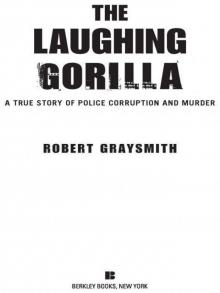 The Laughing Gorilla: A True Story of Police Corruption and Murder
The Laughing Gorilla: A True Story of Police Corruption and Murder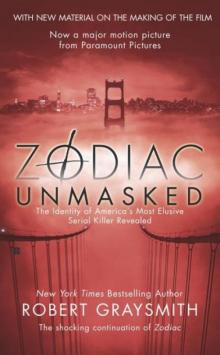 Zodiac Unmasked: The Identity of America's Most Elusive Serial Killer Revealed
Zodiac Unmasked: The Identity of America's Most Elusive Serial Killer Revealed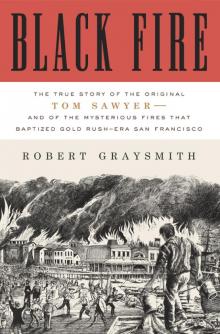 Black Fire: The True Story of the Original Tom Sawyer
Black Fire: The True Story of the Original Tom Sawyer Zodiac Unmasked: The Identity of America's Most Elusive Serial Killers Revealed
Zodiac Unmasked: The Identity of America's Most Elusive Serial Killers Revealed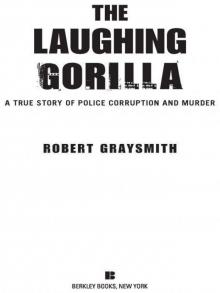 The Laughing Gorilla
The Laughing Gorilla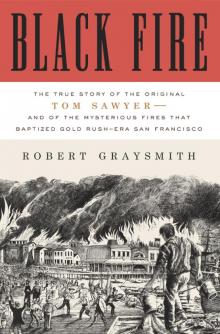 Black Fire
Black Fire